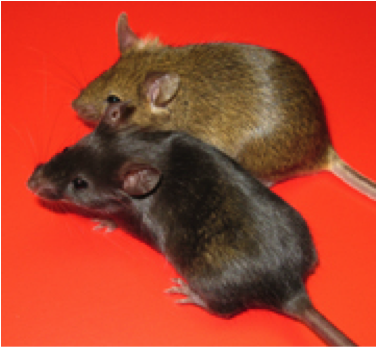Greg Barsh, MD, PhD
Melanocortin Signaling
 The spectrum of color and diversity of patterns in mammals arises from variation in the quantity, quality and regional distribution of two types of pigment – black eumelanin and yellow pheomelanin. Switching between eumelanin and pheomelanin production – a process commonly known as pigment “type-switching” – is controlled primarily by the melanocortin system, in which a family of G protein-coupled receptors has been implicated not only in pigmentation but also in cortisol production, body weight regulation and exocrine gland secretion.
The spectrum of color and diversity of patterns in mammals arises from variation in the quantity, quality and regional distribution of two types of pigment – black eumelanin and yellow pheomelanin. Switching between eumelanin and pheomelanin production – a process commonly known as pigment “type-switching” – is controlled primarily by the melanocortin system, in which a family of G protein-coupled receptors has been implicated not only in pigmentation but also in cortisol production, body weight regulation and exocrine gland secretion.
Two “classical” coat color mutations in non-model organisms, Orange in the domestic cat and Sex-linked yellow (Sly) in the Syrian hamster are especially interesting because they are X-linked, yet mimic a loss-of-function mutation in the autosomal Melanocortin 1 Receptor (Mc1r). These apparent exceptions to Ohno’s law – conservation of gene content on the X chromosome across all eutherian species – offer the potential for new insight into a critical paracrine signaling pathway used by the neuroendocrine, adrenal, exocrine, and pigmentary systems.
In the Barsh Lab, we employ experimental genetic studies in cultured cells and in transgenic animals to confirm the causal role of the Orange deletion and to investigate the molecular pathophysiology. We use genome editing technology to delete the homologous region in mouse and human melanocytes and evaluate the consequences on gene expression and cellular phenotype. We also manipulate expression of Arhgap36 in cultured cells and in transgenic mice to determine if and how Arhgap36 intersects with melanocortin receptor signaling.
At the same time, the lab is directing our efforts toward molecular identification and characterization of the hamster Sly mutation. Sly is similar to Orange with regard to its epistatic and developmental interactions, and preliminary digital gene expression profiling data suggests that the effects of Sly also impinge on melanocortin receptor signaling. We use deep RNA-Seq data of mutant and non-mutant tissues to develop an assembled transcriptome, identify single nucleotide variants (SNVs) associated with the mutation, and use those SNVs to refine the region to a critical interval suitable for targeted resequencing by clone-adapted capture. Bioinformatic analysis of transcriptome and genome sequencing data will reveal potential regulatory and/or coding alterations that cause Sex-linked yellow.
Significance: the melanocortin system in biology and disease
Our discovery 15 years ago of Agrp as a central melanocortin receptor antagonist was presaged by earlier genetic studies of the Ay mutation, in which ectopic expression of Asip causes obesity due to its ability to mimic the effects of Agrp. Studies by us of the Asip-Mc1r and the Agrp-Mc3r/Mc4r pathway have provided new insight into many aspects of endocrine and neuroendocrine signaling. For example, mutations of Mc4r account for 3-4% of severe childhood obesity.
Pigment type-switching is a “model phenotype” because it provides a very sensitive readout of melanocortin signaling. However, the implications of pigment type-switching for human disease extend beyond diabetes and obesity.
Overall, studies of pigment type-switching have and will continue to lead to a deeper understanding of diverse biological processes and human disease because much of the molecular machinery used by the pigmentary system is either shared by, or homologous to, molecules used in other physiological pathways.
